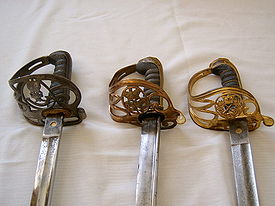Infantry Weapons
This article is confined to weapons used by infantry in British India.
Musket
The infantryman's weapon from 1650 onwards was the muzzle loading smooth bore flintlock musket. Manufacture was standardised to facilitate repair and ammunition supply and led to the production of the Land Pattern musket which was nicknamed Brown Bess. Firing an 18 mm lead ball, the effective range of the Brown Bess was only about 175 yards (160 m). No wonder the tribesmen were at an advantage in the 1st Afghan War. The jezail was said to be effective at 500 yards.
From the Long Land Pattern in 1722 developed the Short Land Pattern and In the 1760s the India Pattern was produced for the East India Company. This last was in service until 1854.
Rifle
The first rifled weapons were rifled muskets which were originally converted smooth bore muskets. The Pattern 1853 Enfield replaced the Brown Bess and was in service until 1867. Its introduction with greased paper wrapped cartridges was a major cause of the Indian Mutiny.
The Snider-Enfield breech loading rifle was introduced in 1866 and was in service with the British Indian Army almost to the end of the 19th century.
Though the Martini-Henry breech loading rifle was introduced in 1871 it did not come into service in India until 20 years later.
Bayonet
The Brown Bess was equipped with a triangular bladed offset bayonet. The musket's slow reload time meant that numbers of the charging enemy were often able to get through to the infantry line. The bayonet was then the soldier's only defence. The sword bayonet was developed for the Pattern 1856 Enfield and was able to be used detached from the rifle as a weapon or as a general tool. In 1871 the Elcho Bayonet was designed to work with the Martini-Henry rifle.
Sword
Officers in the infantry were armed with a sword. From the end of the 18th century this was the 1796 Pattern British Infantry Officer's Sword. It was not considered a good fighting weapon. Light infantry who generally fought away from the regular infantry line used the 1803 Pattern British Infantry Sword until 1822.
The Gothic Hilted British Infantry Sword was introduced in 1822 and modified versions have been in use to the present day. The 1845 Pattern Sword was made by Wilkinson and was in service during the Indian Mutiny. It was compared very unfavourably to the Indian talwar by William Forbes-Mitchell. The 1892 Pattern Sword was reputed to be a much better fighting weapon.
External links
Jezail www.pashtunforums.com
1853 socket bayonet a rms2armor.com
Enfield sword bayonet arms2armor.com
Enfield Rifles in India from Enfield-Stuff.com
The India Pattern Musket barry-lewis.com
Historical books on-line
A Complete System of Bayonet Exercise by Richard Burton 1853. Written by Burton when a lieutenant in the Bombay Army.
